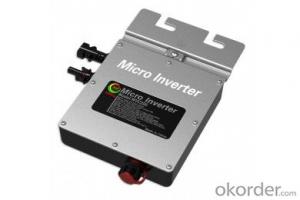KD-WVC295 Series Micro Inverter,High Efficiency & Best Cost-Effectiveness
- Loading Port:
- China main port
- Payment Terms:
- TT OR LC
- Min Order Qty:
- 1000 pc
- Supply Capability:
- 100000 pc/month
OKorder Service Pledge
OKorder Financial Service
You Might Also Like
Structure
The transition from a centralized to a distributed inverter optimizes energy collection.
The converter module integrated into the solar panels can reduce installation costs.
Soft switch technology to replace hard-switching technology can improve efficiency and reduce heat dissipation.
From cottage industry to mass production, standardized design (hardware and software) to improve reliability and reduce costs.
Using a special capacitor (due to the high failure rate). Design requires a higher voltage to reduce the current, we use a special electrolytic capacitors.
The converter can be connected to the grid to eliminate the need for many battery applications. The high price of batteries, require maintenance, life expectancy is shorter.
Work required micro-inverter power increasingly smaller (only a few hundred watts), which can reduce the internal temperature and improve reliability.
Micro-inverter solar inverter system needs to deal with a lot of a particular power level, in order to increase production, thereby reducing costs.
DC input voltage range:22-50VDC
AC output voltage range:80-160VAC/180-260VAC
AC output power :260W
AC frequency range:50Hz/60Hz
G.W.:0.88KG
Size:245mm*200mm*30mm
KD-WVC295 Series Using IP67 waterproof streamline design, Can effectively prevent rainwater on the surface erosion, Built-in high-performance Maximum Power Point Tracking(MPPT)Function,Better able to track changes in the solar luminosity and control different output power, Effectively capture and collect sunlight. AC electric power transmission using the reverse transmission technology, Is one of our patented technology, The inverter output power can provide load priority use, Extra electricity to the grid, Efficient use of the inverter to the power emitted, Electricity transmission rate of up to 99%.
Features
Pure Sine Wave Output;
High performance Maximum Power Point Tracking(MPPT);
Power Automatically Locked(APL);
Reverse power transmission;
High-Frequency High Conversion Rate;
Anti-Islanding Protect;
Input /output is fully isolated to protect the electrical safety;
Multiple parallel stacking;
The Leading Patent Technology;
IP65 WaterProof;
Flexible Installation;
Simplify maintenance (user serviceable)
High Efficiency & Best Cost-Effectiveness
Images

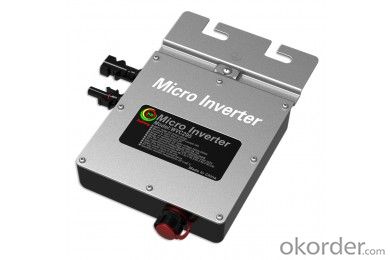
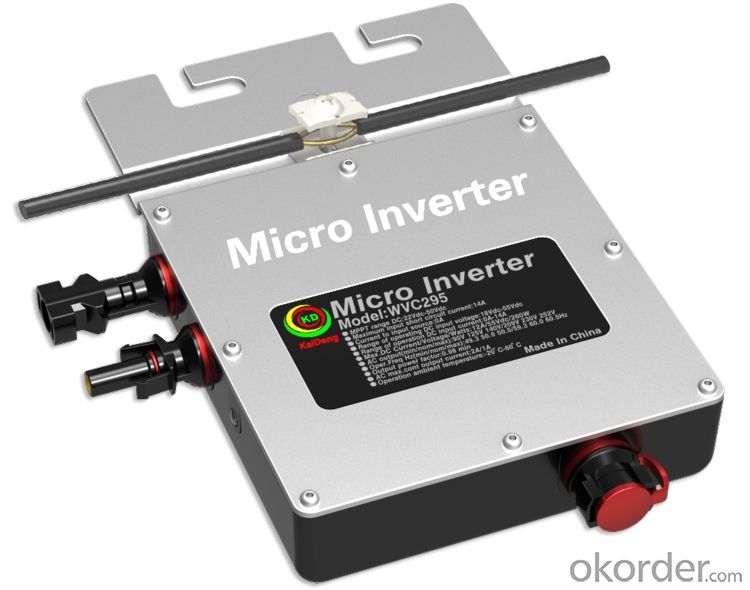
Specification
Input Data | KD-WV250-120VAC/230VAC | |||
Recommended input power | 200-300Watt | |||
Recommend the use of PV modules | 300W/Vmp>34V/Voc<50v< span=""> | |||
Maximum input DC voltage | 50V | |||
Peak power tracking voltage | 25-40V | |||
Operating Voltage Range | 17-50V | |||
Min / Max start voltage | 22-50V | |||
Maximum DC short current | 15A | |||
Maximum Input Current | 9.8A | |||
Output Data | @120VAC | @230VAC | ||
Peak power output | 260Watt | 260Watt | ||
Rated output power | 250Watt | 250Watt | ||
Rated output current | 2.08A | 0.92A | ||
Rated voltage range | 80-160VAC | 180-260VAC | ||
Rated frequency range | 57-62.5Hz | 47-52.5Hz | ||
Power factor | >96% | >96% | ||
Maximum units per branch circuit | 15PCS(Single-phase) | 30PCS(Single-phase) | ||
Output Efficiency | @120VAC | @230VAC | ||
Static MPPT efficiency | 99.5% | 99.5% | ||
Maximum output efficiency | 92.3% | 94.6% | ||
The average efficiency | 91.2% | 93.1% | ||
Night time power consumption | <50mW Max | <70mW Max | ||
THDI | <5%< span=""> | <5%< span=""> | ||
Exterior | ||||
Ambient temperature | -40°C to +60°C | |||
Operating temperature range (inverter inside) | -40°C to +82°C | |||
Dimensions (WxHxD) | 191mm*1176mm*38mm | |||
Weight | 0.83kg | |||
Waterproof Rating | IP65 | |||
Cooling | Self-cooling | |||
Feature | ||||
Power transmission mode | Reverse transfer, load priority | |||
Electromagnetic compatibility | EN50081.part1EN50082.part1 | |||
Grid disturbance | EN61000-3-2 Safety EN62109 | |||
Grid detection | DIN VDE 1026 UL1741 | |||
Certificate | CEC,CE National patent technology | |||
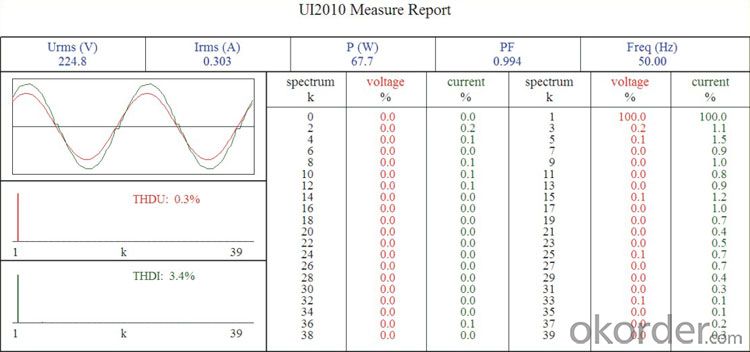
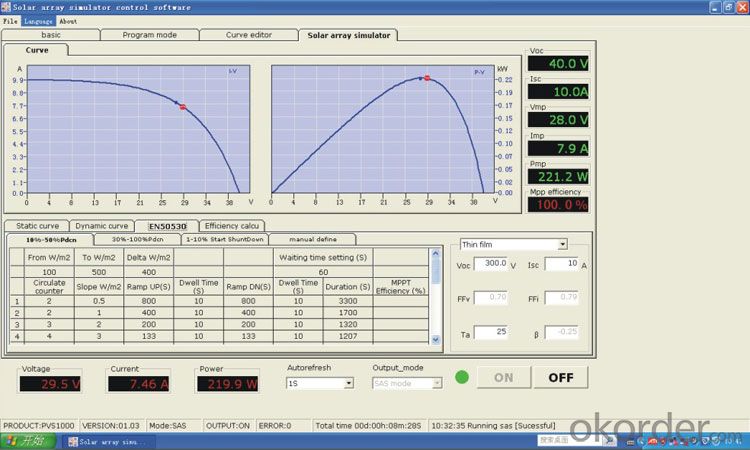
FAQ
Can we visit your factory?
Surely, I will arrange the trip basing on your business schedule.
Can you do OEM for us?
Yes, we can.
How do you pack your products?
We have rich experience on how to pack the panels to make sure the safety on shipment when it arrives at the destination.
Can you help us install the module if we cooperate with you?
We haven’t entered into installation sector, but we have the plan in near future.
- Q:What certifications should I look for when choosing a solar inverter?
- When choosing a solar inverter, it is important to look for certifications such as IEC 62109 or UL 1741. These certifications ensure that the inverter meets necessary safety and performance standards. Additionally, certifications like ISO 9001 indicate that the manufacturer follows quality management systems.
- Q:How does a solar inverter handle power export limitations imposed by the grid?
- A solar inverter handles power export limitations imposed by the grid through a process called power factor control. The inverter continuously monitors the grid's voltage and frequency, adjusting its power output accordingly. If the grid imposes limitations on power export, the inverter reduces its output to stay within the allowed limits. This ensures that the solar system operates in compliance with the grid regulations and prevents any excess power from flowing back into the grid.
- Q:Can a solar inverter be used in areas with unstable grid connections?
- Yes, a solar inverter can be used in areas with unstable grid connections. Solar inverters are designed to convert the DC power generated by solar panels into usable AC power for consumption or to be fed back into the grid. In areas with unstable grid connections, solar inverters can still function and provide power by utilizing battery storage systems or operating in off-grid mode. This allows for uninterrupted power supply and provides stability in areas with unreliable grid connections.
- Q:What is the role of a solar inverter in protecting the electrical grid?
- The role of a solar inverter in protecting the electrical grid is to ensure the safe and efficient integration of solar power into the grid. It converts the direct current (DC) produced by solar panels into alternating current (AC) that is compatible with the grid. Additionally, solar inverters monitor and regulate the flow of electricity, providing grid stability by managing voltage and frequency fluctuations. They also incorporate safety mechanisms to disconnect from the grid in case of emergencies or grid disturbances, protecting both the solar system and the overall electrical grid.
- Q:What is the maximum efficiency of a solar inverter?
- The maximum efficiency of a solar inverter typically ranges from 95% to 98%.
- Q:How is the output voltage of a solar inverter regulated?
- The output voltage of a solar inverter is regulated through the use of control circuitry and power electronics components. These components monitor the input voltage from the solar panels and adjust the output voltage to meet the desired specifications. The control circuitry ensures that the output voltage remains stable and within the required range, even when there are fluctuations in the input voltage or varying load conditions.
- Q:How do you calculate the maximum power point voltage for a solar inverter?
- To calculate the maximum power point voltage for a solar inverter, you need to determine the voltage at which the solar panels generate the maximum power output. This is done by varying the load resistance and measuring the corresponding power output. The maximum power point voltage is the voltage at which the power output is highest.
- Q:What is the role of MPPT (Maximum Power Point Tracking) in a solar inverter?
- The role of MPPT (Maximum Power Point Tracking) in a solar inverter is to optimize the efficiency of the solar panel system by continuously adjusting the voltage and current to ensure that the panel operates at its maximum power point. This helps to extract the maximum available power from the solar panels under varying environmental conditions, such as changes in sunlight intensity or temperature. By dynamically tracking the optimal operating point, MPPT maximizes the energy output of the solar panels and improves the overall performance of the solar inverter system.
- Q:Can a solar inverter be used with a solar-powered water pumping system?
- Yes, a solar inverter can be used with a solar-powered water pumping system. A solar inverter is responsible for converting the direct current (DC) electricity generated by the solar panels into alternating current (AC) electricity, which is required to power the water pump. Therefore, a solar inverter is a crucial component in ensuring the efficient operation of a solar-powered water pumping system.
- Q:How does a solar inverter handle voltage and frequency variations caused by sudden load changes?
- Efficient and reliable, a solar inverter is specifically engineered to manage fluctuations in voltage and frequency resulting from sudden changes in load. When such changes occur, the solar inverter effectively employs a variety of control mechanisms to regulate and stabilize the output voltage and frequency. To begin with, the inverter continuously monitors the incoming solar power, keeping a close eye on the voltage and frequency. If any variations arise due to sudden load changes, the inverter promptly adjusts its internal control systems to compensate. Utilizing advanced power electronics and control algorithms, the inverter ensures that the voltage and frequency remain within the desired range. In order to handle voltage fluctuations caused by sudden load changes, the solar inverter utilizes a technique known as voltage regulation. It automatically adjusts the output voltage, either raising or lowering it as necessary. This guarantees that the inverter delivers a steady and consistent voltage supply to the load, effectively preventing any harm or malfunction. Similarly, to address frequency variations brought on by sudden load changes, the solar inverter employs a technique called frequency regulation. It adjusts the output frequency to match the grid frequency or meet specific frequency requirements. By maintaining the desired frequency, the inverter ensures compatibility and synchronization with the grid or other connected devices. In addition to voltage and frequency regulation, solar inverters also incorporate protective features to handle sudden load changes. They are equipped with built-in overload protection mechanisms capable of detecting excessive loads and preventing damage to both the inverter and the connected devices. These protective features may include safeguards such as overcurrent protection, short-circuit protection, and temperature monitoring. In summary, a solar inverter is purposefully designed to effectively manage voltage and frequency variations arising from sudden load changes. Through its voltage and frequency regulation capabilities, as well as its protective features, the inverter ensures stable and reliable operation. This enables the inverter to adapt efficiently to changing load conditions while safeguarding the integrity of the power supply.
1. Manufacturer Overview |
|
|---|---|
| Location | |
| Year Established | |
| Annual Output Value | |
| Main Markets | |
| Company Certifications | |
2. Manufacturer Certificates |
|
|---|---|
| a) Certification Name | |
| Range | |
| Reference | |
| Validity Period | |
3. Manufacturer Capability |
|
|---|---|
| a)Trade Capacity | |
| Nearest Port | |
| Export Percentage | |
| No.of Employees in Trade Department | |
| Language Spoken: | |
| b)Factory Information | |
| Factory Size: | |
| No. of Production Lines | |
| Contract Manufacturing | |
| Product Price Range | |
Send your message to us
KD-WVC295 Series Micro Inverter,High Efficiency & Best Cost-Effectiveness
- Loading Port:
- China main port
- Payment Terms:
- TT OR LC
- Min Order Qty:
- 1000 pc
- Supply Capability:
- 100000 pc/month
OKorder Service Pledge
OKorder Financial Service
Similar products
New products
Hot products
Hot Searches
Related keywords
